The Harlem Riot of 1964: Causes, Events, and Aftermath
VerifiedAdded on 2021/12/17
|10
|1877
|164
Essay
AI Summary
This essay provides an in-depth analysis of the 1964 Harlem Riot, examining its historical context, causes, and consequences. The essay highlights the pervasive racism and police brutality faced by African Americans, particularly focusing on the shooting of James Powell and the subsequent unrest. It details the role of organizations like CORE and NAACP in demanding justice and fighting for a civilian review board to address police misconduct. The essay also explores the broader urban issues and the struggles of Puerto Rican communities against police brutality. It concludes by emphasizing the riot's significance as a manifestation of accumulated frustrations and the failure of the government to uphold the promises of liberty and equality, as well as the influence it had on other cities in America.
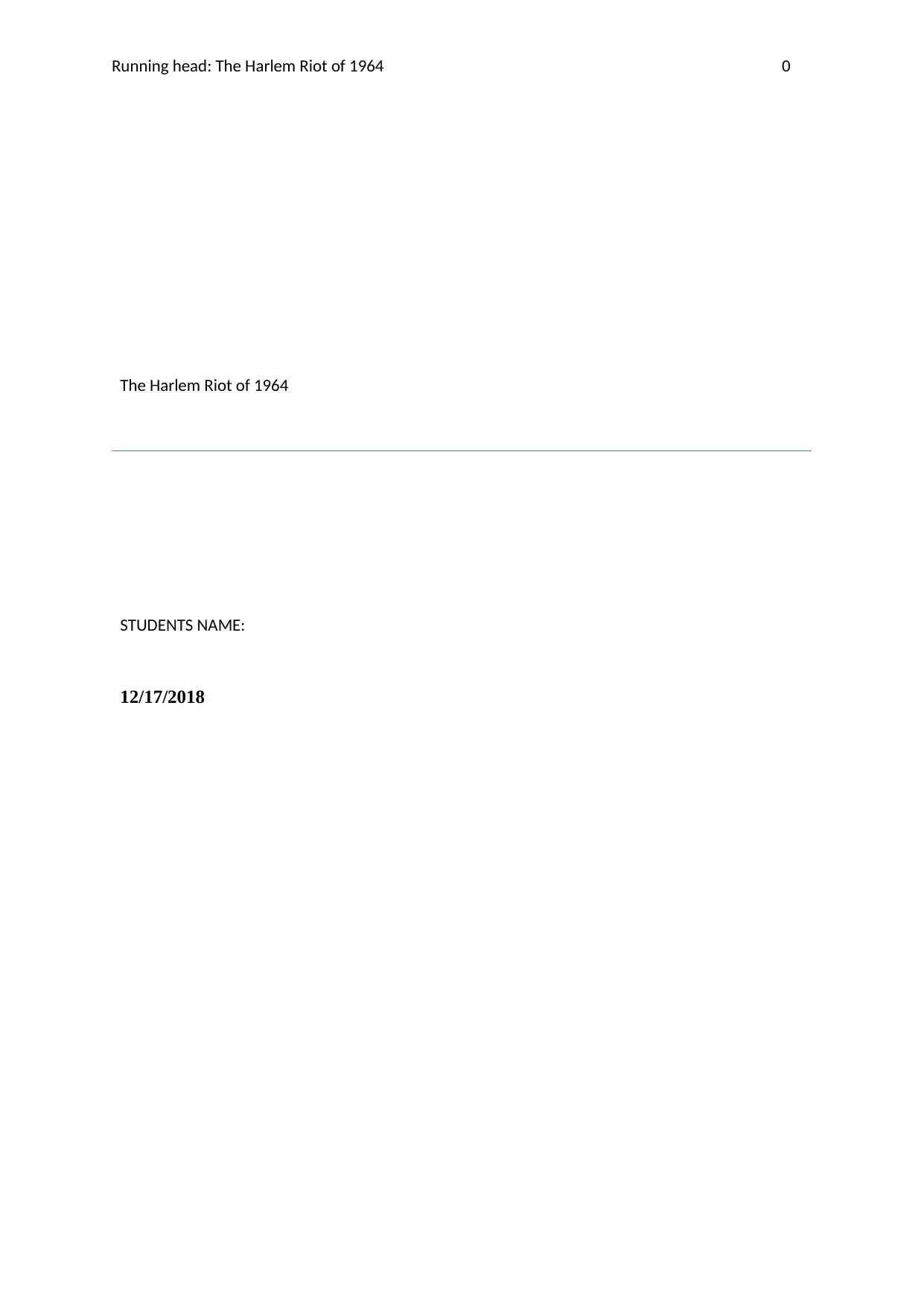
Running head: The Harlem Riot of 1964 0
The Harlem Riot of 1964
STUDENTS NAME:
12/17/2018
The Harlem Riot of 1964
STUDENTS NAME:
12/17/2018
Paraphrase This Document
Need a fresh take? Get an instant paraphrase of this document with our AI Paraphraser
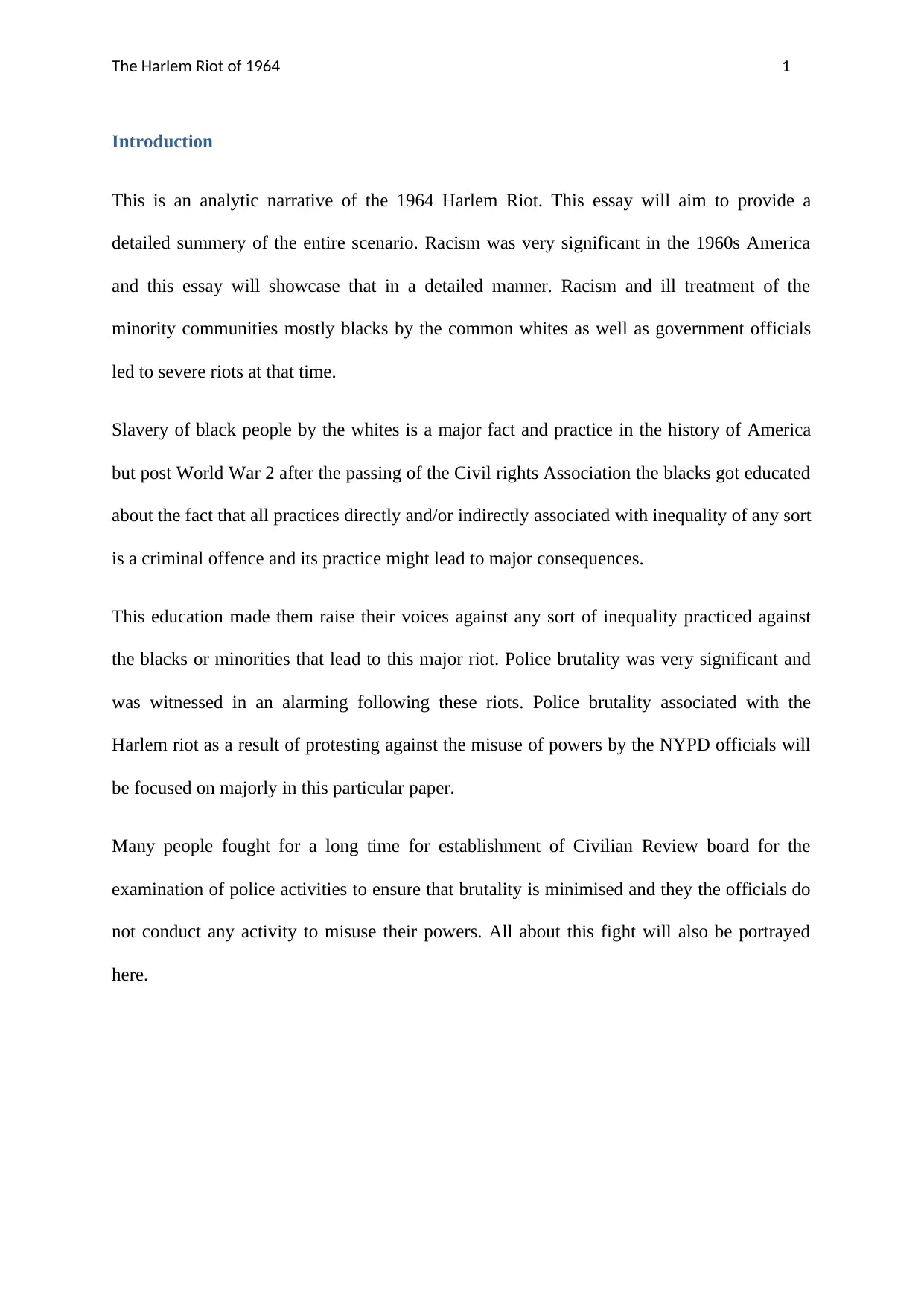
The Harlem Riot of 1964 1
Introduction
This is an analytic narrative of the 1964 Harlem Riot. This essay will aim to provide a
detailed summery of the entire scenario. Racism was very significant in the 1960s America
and this essay will showcase that in a detailed manner. Racism and ill treatment of the
minority communities mostly blacks by the common whites as well as government officials
led to severe riots at that time.
Slavery of black people by the whites is a major fact and practice in the history of America
but post World War 2 after the passing of the Civil rights Association the blacks got educated
about the fact that all practices directly and/or indirectly associated with inequality of any sort
is a criminal offence and its practice might lead to major consequences.
This education made them raise their voices against any sort of inequality practiced against
the blacks or minorities that lead to this major riot. Police brutality was very significant and
was witnessed in an alarming following these riots. Police brutality associated with the
Harlem riot as a result of protesting against the misuse of powers by the NYPD officials will
be focused on majorly in this particular paper.
Many people fought for a long time for establishment of Civilian Review board for the
examination of police activities to ensure that brutality is minimised and they the officials do
not conduct any activity to misuse their powers. All about this fight will also be portrayed
here.
Introduction
This is an analytic narrative of the 1964 Harlem Riot. This essay will aim to provide a
detailed summery of the entire scenario. Racism was very significant in the 1960s America
and this essay will showcase that in a detailed manner. Racism and ill treatment of the
minority communities mostly blacks by the common whites as well as government officials
led to severe riots at that time.
Slavery of black people by the whites is a major fact and practice in the history of America
but post World War 2 after the passing of the Civil rights Association the blacks got educated
about the fact that all practices directly and/or indirectly associated with inequality of any sort
is a criminal offence and its practice might lead to major consequences.
This education made them raise their voices against any sort of inequality practiced against
the blacks or minorities that lead to this major riot. Police brutality was very significant and
was witnessed in an alarming following these riots. Police brutality associated with the
Harlem riot as a result of protesting against the misuse of powers by the NYPD officials will
be focused on majorly in this particular paper.
Many people fought for a long time for establishment of Civilian Review board for the
examination of police activities to ensure that brutality is minimised and they the officials do
not conduct any activity to misuse their powers. All about this fight will also be portrayed
here.
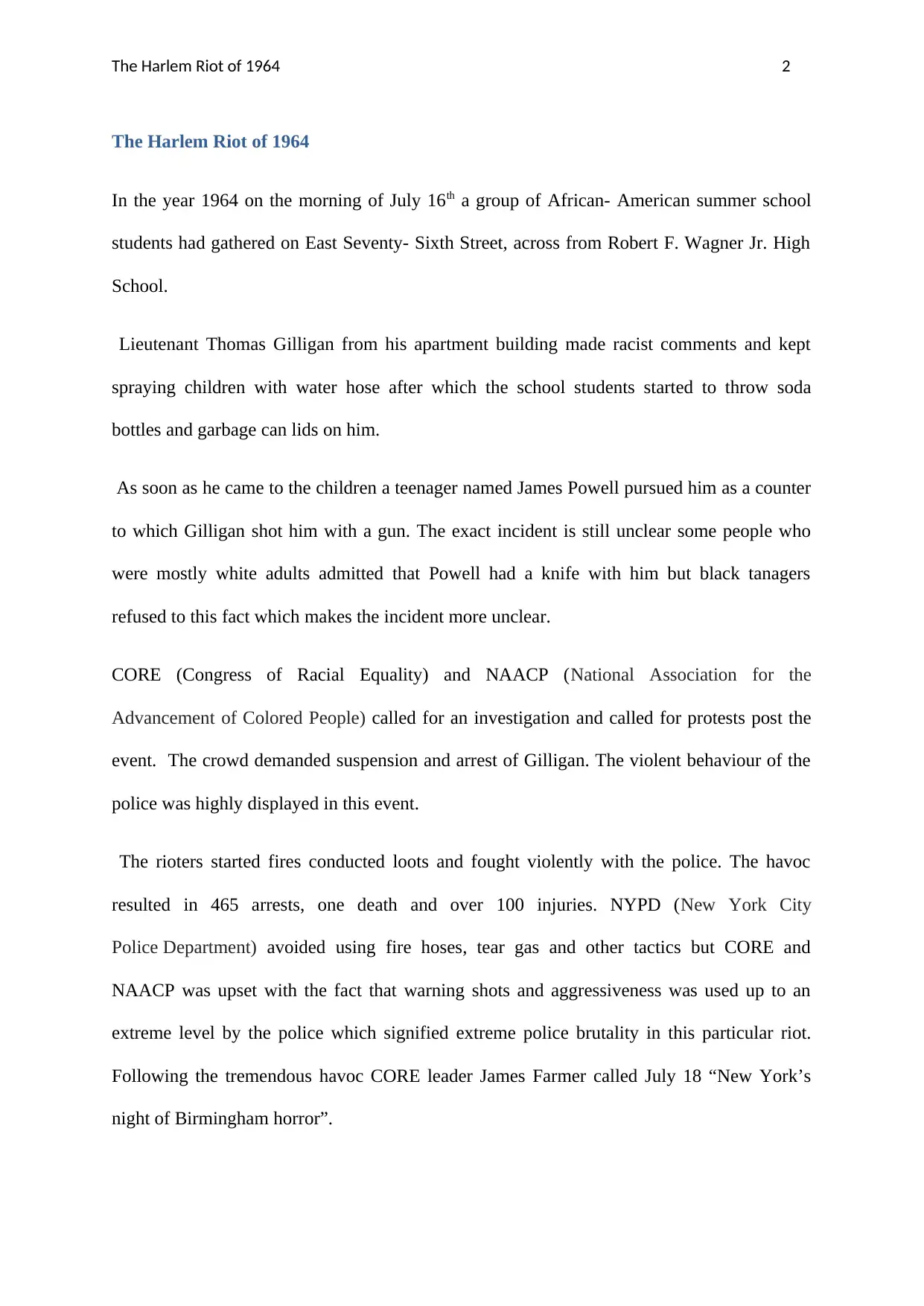
The Harlem Riot of 1964 2
The Harlem Riot of 1964
In the year 1964 on the morning of July 16th a group of African- American summer school
students had gathered on East Seventy- Sixth Street, across from Robert F. Wagner Jr. High
School.
Lieutenant Thomas Gilligan from his apartment building made racist comments and kept
spraying children with water hose after which the school students started to throw soda
bottles and garbage can lids on him.
As soon as he came to the children a teenager named James Powell pursued him as a counter
to which Gilligan shot him with a gun. The exact incident is still unclear some people who
were mostly white adults admitted that Powell had a knife with him but black tanagers
refused to this fact which makes the incident more unclear.
CORE (Congress of Racial Equality) and NAACP (National Association for the
Advancement of Colored People) called for an investigation and called for protests post the
event. The crowd demanded suspension and arrest of Gilligan. The violent behaviour of the
police was highly displayed in this event.
The rioters started fires conducted loots and fought violently with the police. The havoc
resulted in 465 arrests, one death and over 100 injuries. NYPD (New York City
Police Department) avoided using fire hoses, tear gas and other tactics but CORE and
NAACP was upset with the fact that warning shots and aggressiveness was used up to an
extreme level by the police which signified extreme police brutality in this particular riot.
Following the tremendous havoc CORE leader James Farmer called July 18 “New York’s
night of Birmingham horror”.
The Harlem Riot of 1964
In the year 1964 on the morning of July 16th a group of African- American summer school
students had gathered on East Seventy- Sixth Street, across from Robert F. Wagner Jr. High
School.
Lieutenant Thomas Gilligan from his apartment building made racist comments and kept
spraying children with water hose after which the school students started to throw soda
bottles and garbage can lids on him.
As soon as he came to the children a teenager named James Powell pursued him as a counter
to which Gilligan shot him with a gun. The exact incident is still unclear some people who
were mostly white adults admitted that Powell had a knife with him but black tanagers
refused to this fact which makes the incident more unclear.
CORE (Congress of Racial Equality) and NAACP (National Association for the
Advancement of Colored People) called for an investigation and called for protests post the
event. The crowd demanded suspension and arrest of Gilligan. The violent behaviour of the
police was highly displayed in this event.
The rioters started fires conducted loots and fought violently with the police. The havoc
resulted in 465 arrests, one death and over 100 injuries. NYPD (New York City
Police Department) avoided using fire hoses, tear gas and other tactics but CORE and
NAACP was upset with the fact that warning shots and aggressiveness was used up to an
extreme level by the police which signified extreme police brutality in this particular riot.
Following the tremendous havoc CORE leader James Farmer called July 18 “New York’s
night of Birmingham horror”.
⊘ This is a preview!⊘
Do you want full access?
Subscribe today to unlock all pages.

Trusted by 1+ million students worldwide
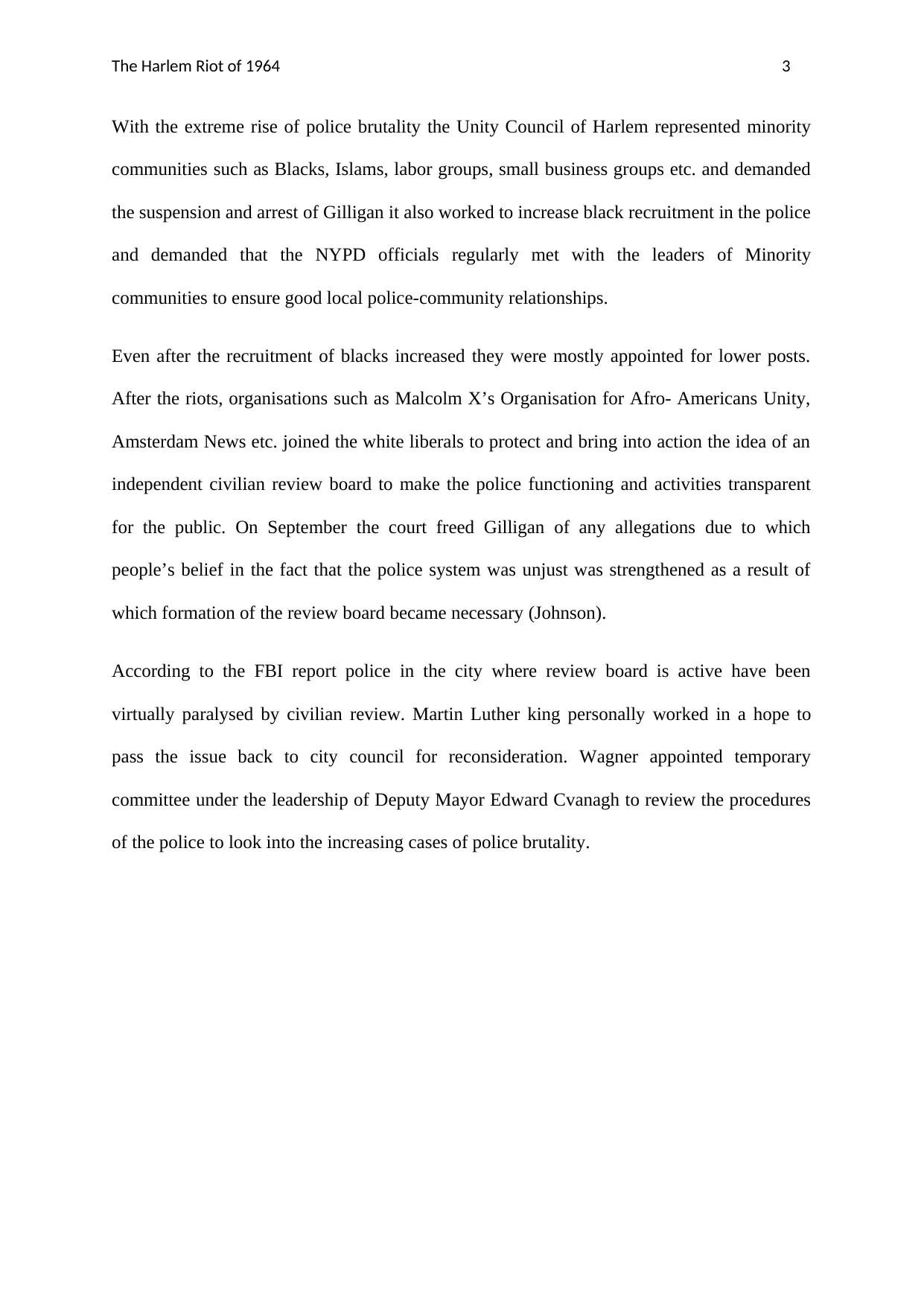
The Harlem Riot of 1964 3
With the extreme rise of police brutality the Unity Council of Harlem represented minority
communities such as Blacks, Islams, labor groups, small business groups etc. and demanded
the suspension and arrest of Gilligan it also worked to increase black recruitment in the police
and demanded that the NYPD officials regularly met with the leaders of Minority
communities to ensure good local police-community relationships.
Even after the recruitment of blacks increased they were mostly appointed for lower posts.
After the riots, organisations such as Malcolm X’s Organisation for Afro- Americans Unity,
Amsterdam News etc. joined the white liberals to protect and bring into action the idea of an
independent civilian review board to make the police functioning and activities transparent
for the public. On September the court freed Gilligan of any allegations due to which
people’s belief in the fact that the police system was unjust was strengthened as a result of
which formation of the review board became necessary (Johnson).
According to the FBI report police in the city where review board is active have been
virtually paralysed by civilian review. Martin Luther king personally worked in a hope to
pass the issue back to city council for reconsideration. Wagner appointed temporary
committee under the leadership of Deputy Mayor Edward Cvanagh to review the procedures
of the police to look into the increasing cases of police brutality.
With the extreme rise of police brutality the Unity Council of Harlem represented minority
communities such as Blacks, Islams, labor groups, small business groups etc. and demanded
the suspension and arrest of Gilligan it also worked to increase black recruitment in the police
and demanded that the NYPD officials regularly met with the leaders of Minority
communities to ensure good local police-community relationships.
Even after the recruitment of blacks increased they were mostly appointed for lower posts.
After the riots, organisations such as Malcolm X’s Organisation for Afro- Americans Unity,
Amsterdam News etc. joined the white liberals to protect and bring into action the idea of an
independent civilian review board to make the police functioning and activities transparent
for the public. On September the court freed Gilligan of any allegations due to which
people’s belief in the fact that the police system was unjust was strengthened as a result of
which formation of the review board became necessary (Johnson).
According to the FBI report police in the city where review board is active have been
virtually paralysed by civilian review. Martin Luther king personally worked in a hope to
pass the issue back to city council for reconsideration. Wagner appointed temporary
committee under the leadership of Deputy Mayor Edward Cvanagh to review the procedures
of the police to look into the increasing cases of police brutality.
Paraphrase This Document
Need a fresh take? Get an instant paraphrase of this document with our AI Paraphraser
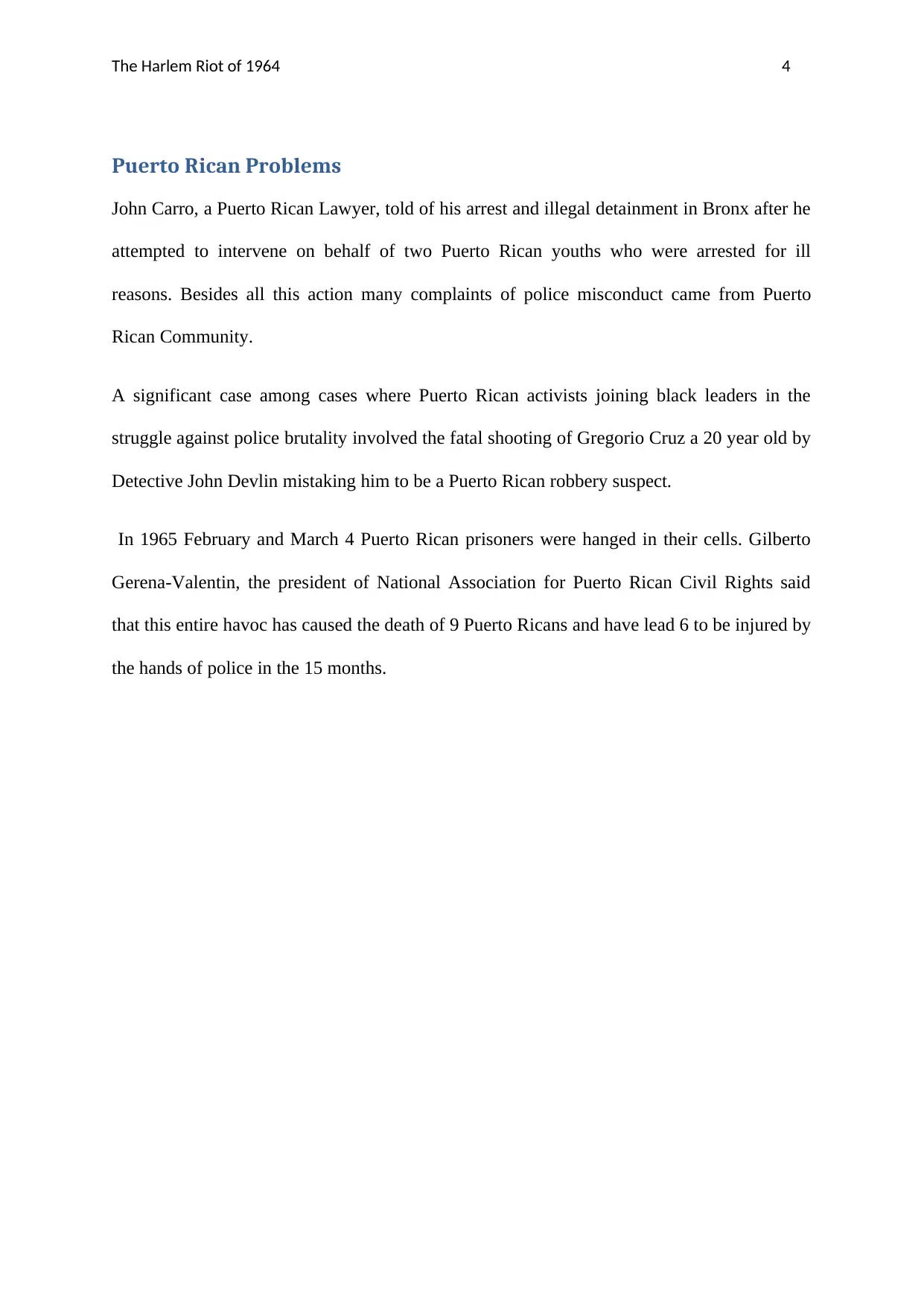
The Harlem Riot of 1964 4
Puerto Rican Problems
John Carro, a Puerto Rican Lawyer, told of his arrest and illegal detainment in Bronx after he
attempted to intervene on behalf of two Puerto Rican youths who were arrested for ill
reasons. Besides all this action many complaints of police misconduct came from Puerto
Rican Community.
A significant case among cases where Puerto Rican activists joining black leaders in the
struggle against police brutality involved the fatal shooting of Gregorio Cruz a 20 year old by
Detective John Devlin mistaking him to be a Puerto Rican robbery suspect.
In 1965 February and March 4 Puerto Rican prisoners were hanged in their cells. Gilberto
Gerena-Valentin, the president of National Association for Puerto Rican Civil Rights said
that this entire havoc has caused the death of 9 Puerto Ricans and have lead 6 to be injured by
the hands of police in the 15 months.
Puerto Rican Problems
John Carro, a Puerto Rican Lawyer, told of his arrest and illegal detainment in Bronx after he
attempted to intervene on behalf of two Puerto Rican youths who were arrested for ill
reasons. Besides all this action many complaints of police misconduct came from Puerto
Rican Community.
A significant case among cases where Puerto Rican activists joining black leaders in the
struggle against police brutality involved the fatal shooting of Gregorio Cruz a 20 year old by
Detective John Devlin mistaking him to be a Puerto Rican robbery suspect.
In 1965 February and March 4 Puerto Rican prisoners were hanged in their cells. Gilberto
Gerena-Valentin, the president of National Association for Puerto Rican Civil Rights said
that this entire havoc has caused the death of 9 Puerto Ricans and have lead 6 to be injured by
the hands of police in the 15 months.
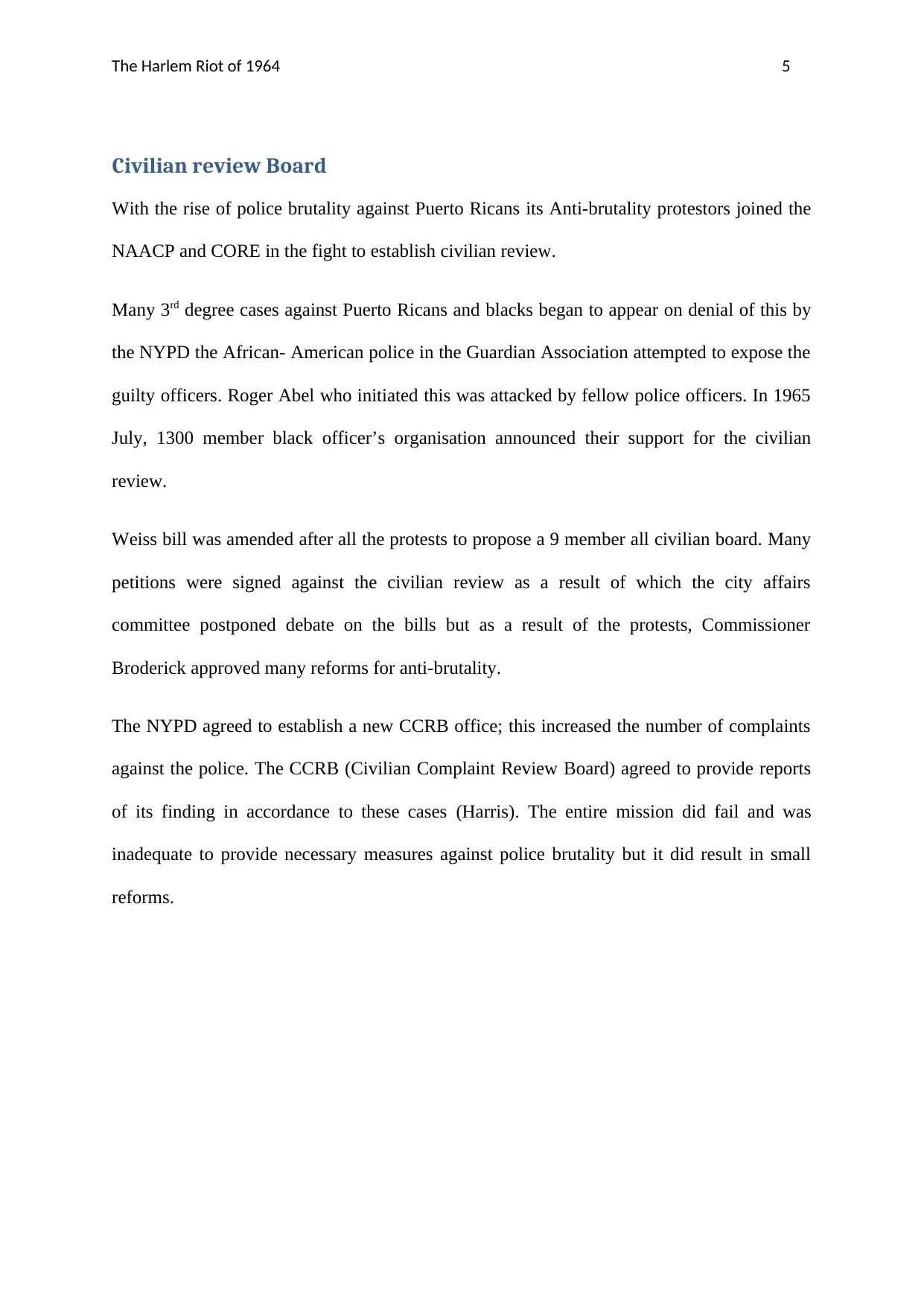
The Harlem Riot of 1964 5
Civilian review Board
With the rise of police brutality against Puerto Ricans its Anti-brutality protestors joined the
NAACP and CORE in the fight to establish civilian review.
Many 3rd degree cases against Puerto Ricans and blacks began to appear on denial of this by
the NYPD the African- American police in the Guardian Association attempted to expose the
guilty officers. Roger Abel who initiated this was attacked by fellow police officers. In 1965
July, 1300 member black officer’s organisation announced their support for the civilian
review.
Weiss bill was amended after all the protests to propose a 9 member all civilian board. Many
petitions were signed against the civilian review as a result of which the city affairs
committee postponed debate on the bills but as a result of the protests, Commissioner
Broderick approved many reforms for anti-brutality.
The NYPD agreed to establish a new CCRB office; this increased the number of complaints
against the police. The CCRB (Civilian Complaint Review Board) agreed to provide reports
of its finding in accordance to these cases (Harris). The entire mission did fail and was
inadequate to provide necessary measures against police brutality but it did result in small
reforms.
Civilian review Board
With the rise of police brutality against Puerto Ricans its Anti-brutality protestors joined the
NAACP and CORE in the fight to establish civilian review.
Many 3rd degree cases against Puerto Ricans and blacks began to appear on denial of this by
the NYPD the African- American police in the Guardian Association attempted to expose the
guilty officers. Roger Abel who initiated this was attacked by fellow police officers. In 1965
July, 1300 member black officer’s organisation announced their support for the civilian
review.
Weiss bill was amended after all the protests to propose a 9 member all civilian board. Many
petitions were signed against the civilian review as a result of which the city affairs
committee postponed debate on the bills but as a result of the protests, Commissioner
Broderick approved many reforms for anti-brutality.
The NYPD agreed to establish a new CCRB office; this increased the number of complaints
against the police. The CCRB (Civilian Complaint Review Board) agreed to provide reports
of its finding in accordance to these cases (Harris). The entire mission did fail and was
inadequate to provide necessary measures against police brutality but it did result in small
reforms.
⊘ This is a preview!⊘
Do you want full access?
Subscribe today to unlock all pages.

Trusted by 1+ million students worldwide
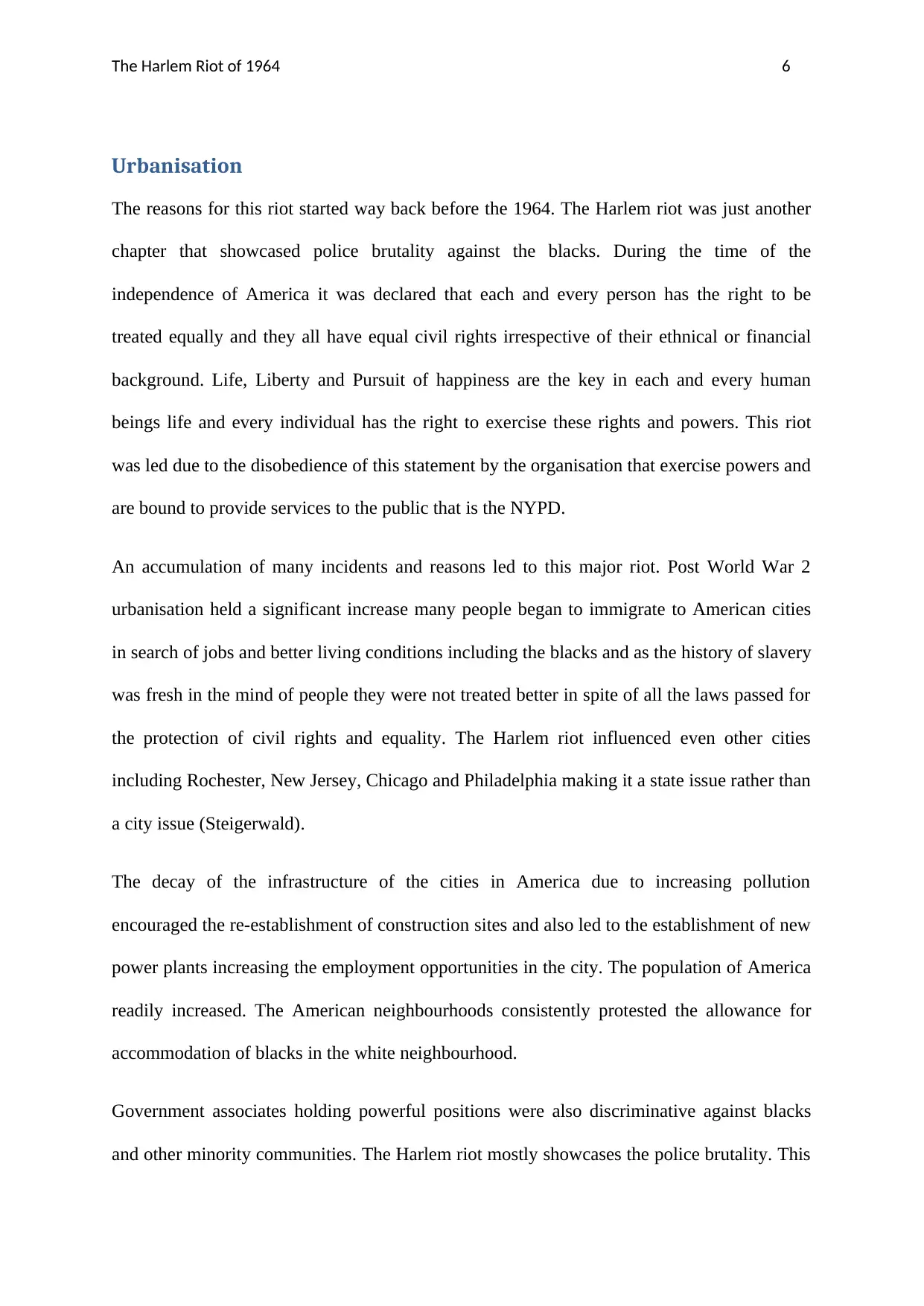
The Harlem Riot of 1964 6
Urbanisation
The reasons for this riot started way back before the 1964. The Harlem riot was just another
chapter that showcased police brutality against the blacks. During the time of the
independence of America it was declared that each and every person has the right to be
treated equally and they all have equal civil rights irrespective of their ethnical or financial
background. Life, Liberty and Pursuit of happiness are the key in each and every human
beings life and every individual has the right to exercise these rights and powers. This riot
was led due to the disobedience of this statement by the organisation that exercise powers and
are bound to provide services to the public that is the NYPD.
An accumulation of many incidents and reasons led to this major riot. Post World War 2
urbanisation held a significant increase many people began to immigrate to American cities
in search of jobs and better living conditions including the blacks and as the history of slavery
was fresh in the mind of people they were not treated better in spite of all the laws passed for
the protection of civil rights and equality. The Harlem riot influenced even other cities
including Rochester, New Jersey, Chicago and Philadelphia making it a state issue rather than
a city issue (Steigerwald).
The decay of the infrastructure of the cities in America due to increasing pollution
encouraged the re-establishment of construction sites and also led to the establishment of new
power plants increasing the employment opportunities in the city. The population of America
readily increased. The American neighbourhoods consistently protested the allowance for
accommodation of blacks in the white neighbourhood.
Government associates holding powerful positions were also discriminative against blacks
and other minority communities. The Harlem riot mostly showcases the police brutality. This
Urbanisation
The reasons for this riot started way back before the 1964. The Harlem riot was just another
chapter that showcased police brutality against the blacks. During the time of the
independence of America it was declared that each and every person has the right to be
treated equally and they all have equal civil rights irrespective of their ethnical or financial
background. Life, Liberty and Pursuit of happiness are the key in each and every human
beings life and every individual has the right to exercise these rights and powers. This riot
was led due to the disobedience of this statement by the organisation that exercise powers and
are bound to provide services to the public that is the NYPD.
An accumulation of many incidents and reasons led to this major riot. Post World War 2
urbanisation held a significant increase many people began to immigrate to American cities
in search of jobs and better living conditions including the blacks and as the history of slavery
was fresh in the mind of people they were not treated better in spite of all the laws passed for
the protection of civil rights and equality. The Harlem riot influenced even other cities
including Rochester, New Jersey, Chicago and Philadelphia making it a state issue rather than
a city issue (Steigerwald).
The decay of the infrastructure of the cities in America due to increasing pollution
encouraged the re-establishment of construction sites and also led to the establishment of new
power plants increasing the employment opportunities in the city. The population of America
readily increased. The American neighbourhoods consistently protested the allowance for
accommodation of blacks in the white neighbourhood.
Government associates holding powerful positions were also discriminative against blacks
and other minority communities. The Harlem riot mostly showcases the police brutality. This
Paraphrase This Document
Need a fresh take? Get an instant paraphrase of this document with our AI Paraphraser
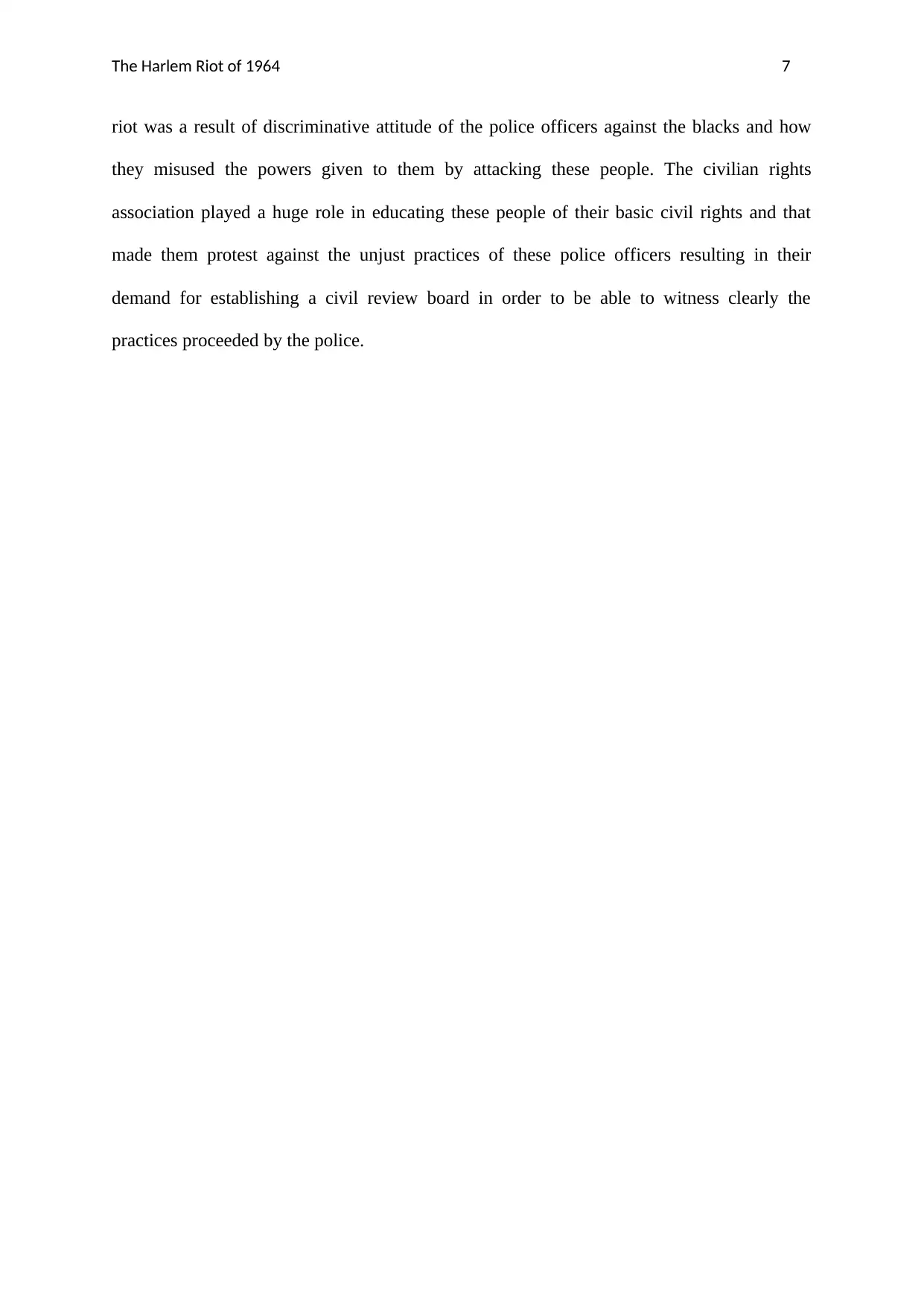
The Harlem Riot of 1964 7
riot was a result of discriminative attitude of the police officers against the blacks and how
they misused the powers given to them by attacking these people. The civilian rights
association played a huge role in educating these people of their basic civil rights and that
made them protest against the unjust practices of these police officers resulting in their
demand for establishing a civil review board in order to be able to witness clearly the
practices proceeded by the police.
riot was a result of discriminative attitude of the police officers against the blacks and how
they misused the powers given to them by attacking these people. The civilian rights
association played a huge role in educating these people of their basic civil rights and that
made them protest against the unjust practices of these police officers resulting in their
demand for establishing a civil review board in order to be able to witness clearly the
practices proceeded by the police.
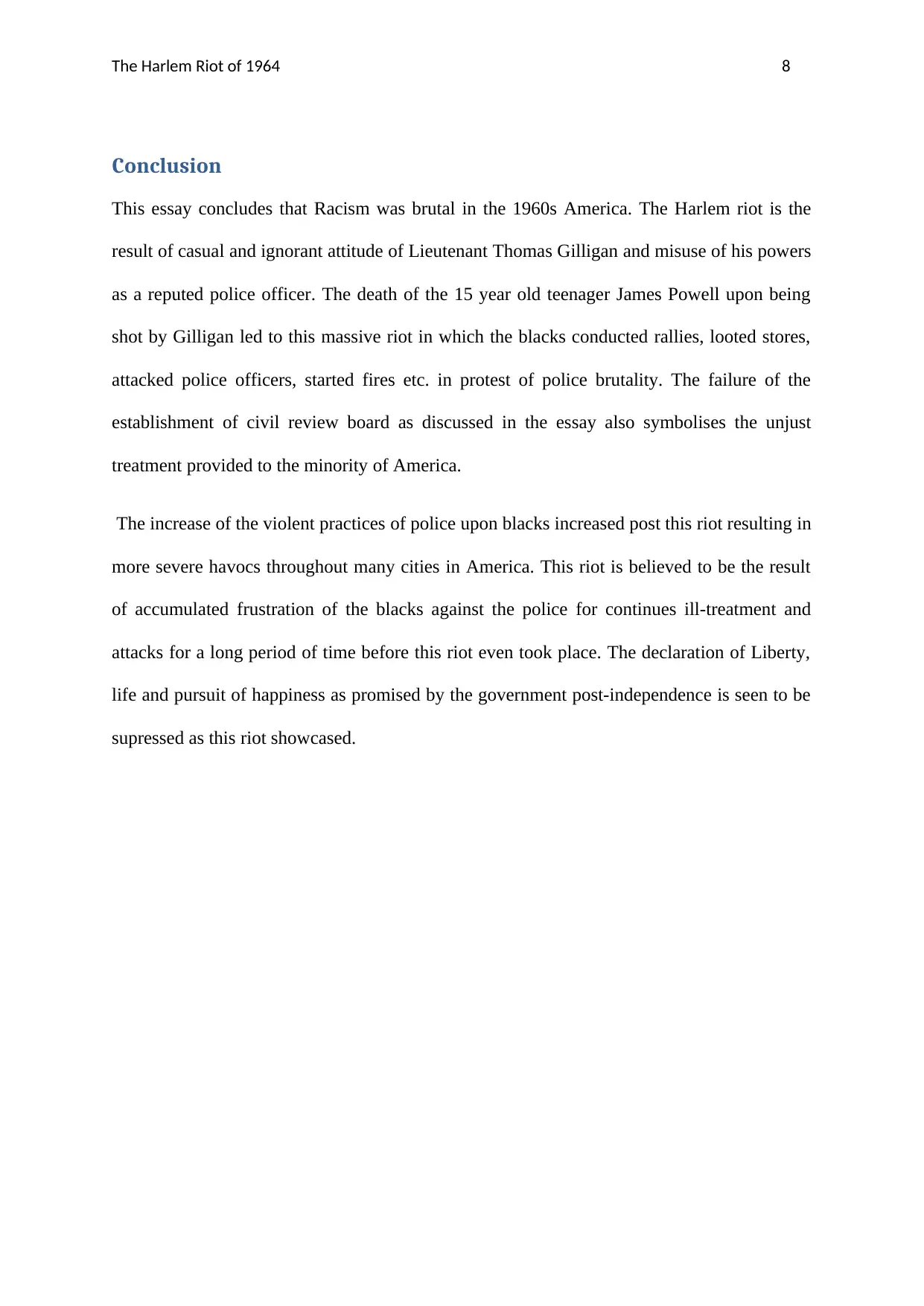
The Harlem Riot of 1964 8
Conclusion
This essay concludes that Racism was brutal in the 1960s America. The Harlem riot is the
result of casual and ignorant attitude of Lieutenant Thomas Gilligan and misuse of his powers
as a reputed police officer. The death of the 15 year old teenager James Powell upon being
shot by Gilligan led to this massive riot in which the blacks conducted rallies, looted stores,
attacked police officers, started fires etc. in protest of police brutality. The failure of the
establishment of civil review board as discussed in the essay also symbolises the unjust
treatment provided to the minority of America.
The increase of the violent practices of police upon blacks increased post this riot resulting in
more severe havocs throughout many cities in America. This riot is believed to be the result
of accumulated frustration of the blacks against the police for continues ill-treatment and
attacks for a long period of time before this riot even took place. The declaration of Liberty,
life and pursuit of happiness as promised by the government post-independence is seen to be
supressed as this riot showcased.
Conclusion
This essay concludes that Racism was brutal in the 1960s America. The Harlem riot is the
result of casual and ignorant attitude of Lieutenant Thomas Gilligan and misuse of his powers
as a reputed police officer. The death of the 15 year old teenager James Powell upon being
shot by Gilligan led to this massive riot in which the blacks conducted rallies, looted stores,
attacked police officers, started fires etc. in protest of police brutality. The failure of the
establishment of civil review board as discussed in the essay also symbolises the unjust
treatment provided to the minority of America.
The increase of the violent practices of police upon blacks increased post this riot resulting in
more severe havocs throughout many cities in America. This riot is believed to be the result
of accumulated frustration of the blacks against the police for continues ill-treatment and
attacks for a long period of time before this riot even took place. The declaration of Liberty,
life and pursuit of happiness as promised by the government post-independence is seen to be
supressed as this riot showcased.
⊘ This is a preview!⊘
Do you want full access?
Subscribe today to unlock all pages.

Trusted by 1+ million students worldwide
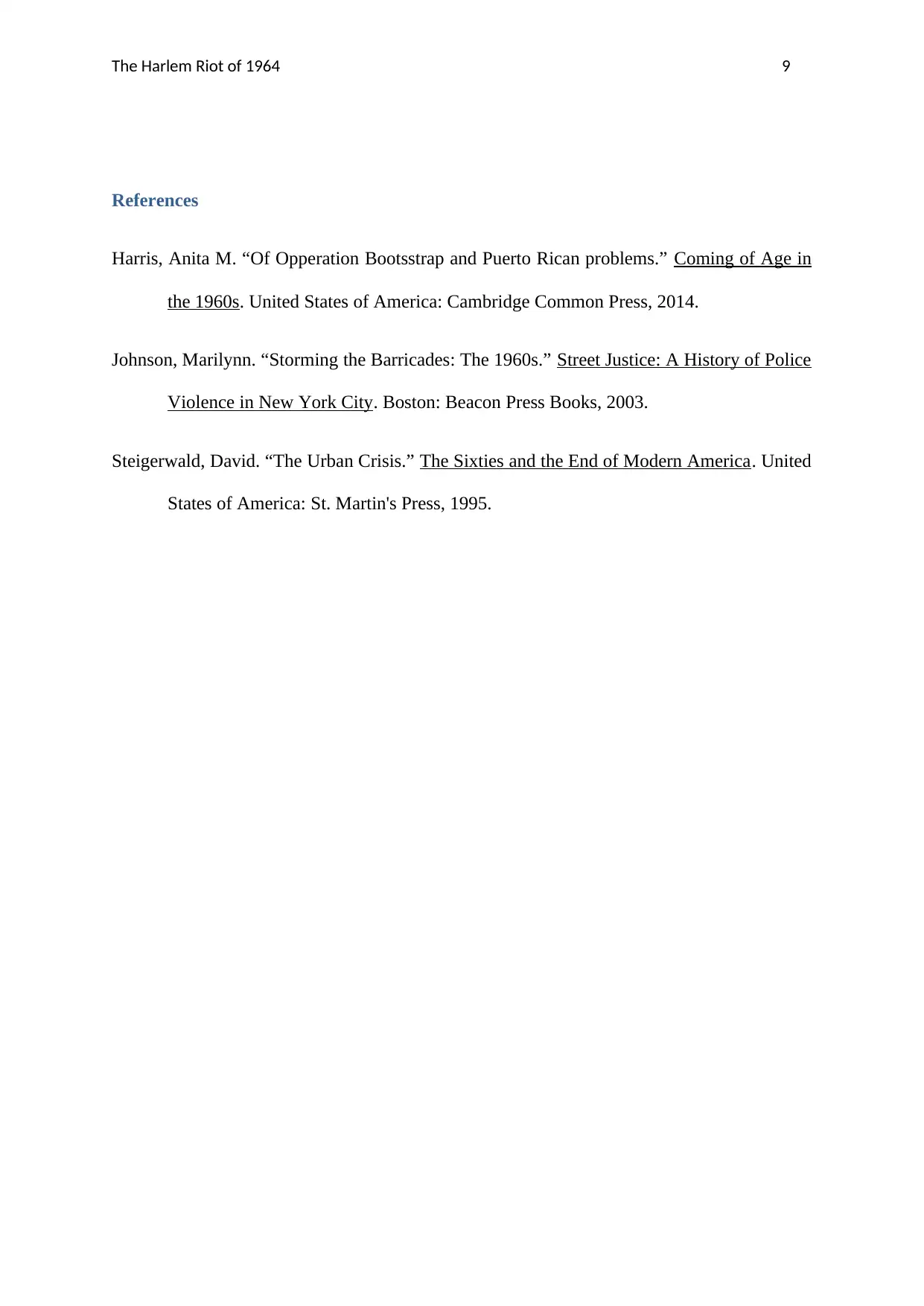
The Harlem Riot of 1964 9
References
Harris, Anita M. “Of Opperation Bootsstrap and Puerto Rican problems.” Coming of Age in
the 1960s. United States of America: Cambridge Common Press, 2014.
Johnson, Marilynn. “Storming the Barricades: The 1960s.” Street Justice: A History of Police
Violence in New York City. Boston: Beacon Press Books, 2003.
Steigerwald, David. “The Urban Crisis.” The Sixties and the End of Modern America. United
States of America: St. Martin's Press, 1995.
References
Harris, Anita M. “Of Opperation Bootsstrap and Puerto Rican problems.” Coming of Age in
the 1960s. United States of America: Cambridge Common Press, 2014.
Johnson, Marilynn. “Storming the Barricades: The 1960s.” Street Justice: A History of Police
Violence in New York City. Boston: Beacon Press Books, 2003.
Steigerwald, David. “The Urban Crisis.” The Sixties and the End of Modern America. United
States of America: St. Martin's Press, 1995.
1 out of 10
Your All-in-One AI-Powered Toolkit for Academic Success.
+13062052269
info@desklib.com
Available 24*7 on WhatsApp / Email
![[object Object]](/_next/static/media/star-bottom.7253800d.svg)
Unlock your academic potential
Copyright © 2020–2025 A2Z Services. All Rights Reserved. Developed and managed by ZUCOL.